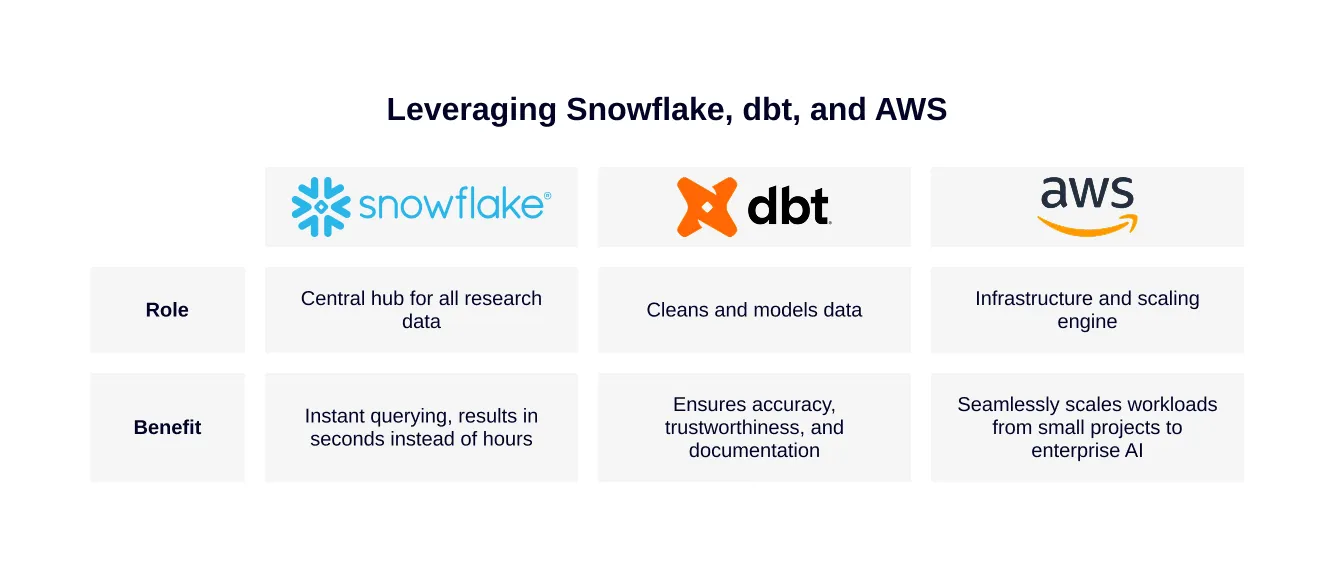Picture this: you’re leading a strategic initiative and need to present findings to the executive team. Your desk is stacked with market research reports, browser tabs are overflowing with analyst insights, and you’re juggling multiple survey tools and data sources that don’t align. Pulling together a single, consistent narrative from all that research feels overwhelming—and you’re not alone.
The reality is stark—over 2.5 million new academic articles are published globally every year. For scholars, professionals, and institutions, the sheer flood of information is both a blessing and a burden. The more knowledge we produce, the harder it becomes to keep pace.
Now imagine a different experience. Instead of drowning in documents, you ask an AI assistant to summarize the top 200 papers on your topic in minutes. It highlights patterns, points you toward relevant data, and even suggests how your work could extend current research. Suddenly, what felt impossible becomes empowering.
This is the new reality AI is ushering in. As Nature’s AI for Science 2025 report highlights, AI is not only accelerating research—it’s “reshaping the very questions scientists are able to ask”. But to unlock these possibilities, researchers need more than just AI tools. They need a strong data and technology foundation that ensures information is accessible, accurate, and AI-ready. That’s where transformation begins.

The Challenge: Information Overload and Outdated Workflows
For decades, research workflows have barely kept up with the pace of knowledge creation.
Traditional barriers to effective research
Most institutions still grapple with:
- Disparate data sources: Journals, archives, and datasets live in silos that rarely communicate with each other. A single literature review might require logging into six or seven different platforms.
- Manual and time-consuming reviews: Scholars spend hundreds of hours combing through papers, often duplicating work done by colleagues.
These inefficiencies do more than frustrate researchers. They slow down discovery, reduce accuracy, and make collaboration difficult. Valuable insights are missed simply because they’re hidden in disconnected systems.
What research needs is not just faster AI tools—it’s an integrated ecosystem. A platform where all data, from structured datasets to unstructured notes, is unified, organized, and governed. This is the foundation that powers AI-driven discovery.
A Modern Approach to Building AI-Powered Research Workflows
At BlueCloud, we’ve seen this problem firsthand. Researchers lack the right infrastructure.
Building an AI-ready research environment is about creating a foundation where all the moving parts work together seamlessly. At BlueCloud, we’ve seen how the right mix of technology and strategy can turn fragmented, inefficient workflows into streamlined ecosystems that unlock entirely new levels of insight. Our approach begins with rebuilding the foundation.
A. Cloud-first strategies
We guide institutions toward cloud-first strategies, ensuring their data isn’t locked in fragile on-prem systems. Cloud infrastructure offers scalability, flexibility, and global access—essentials in today’s research world.
B. Centralizing structured and unstructured data
Our clients often have data scattered across formats: structured databases for experiments, citation indexes, and raw datasets; unstructured content like scanned PDFs, manuscripts, or interview transcripts. BlueCloud helps bring it all together, enabling AI to finally see the full picture.
C. Leveraging Snowflake, dbt, and AWS
Behind every breakthrough paper lies an invisible backbone of technology. By uniting Snowflake, dbt, and AWS, BlueCloud provides researchers with the speed, accuracy, and scale they need to unlock insights that once felt out of reach.
- Snowflake acts as the central hub. Imagine a single place where all your research data lives, ready to be queried instantly. No more waiting hours for results—Snowflake delivers them in seconds.
- dbt cleans and models that data so it’s accurate, trustworthy, and well-documented. Researchers can finally rely on outputs without second-guessing data quality.
- AWS provides the power behind the scenes, scaling workloads as institutions grow, from a handful of projects to enterprise-level AI applications.

With a solid foundation, researchers can explore next-generation AI capabilities: cross-disciplinary pattern recognition, predictive modeling of research trends, and even AI-generated drafts of research papers.
Unlocking Tangible Value with AI for Research Papers
The benefits of this transformation are immediate and measurable.
1. Faster reviews and drafting
Instead of spending 200+ hours on literature reviews, researchers can summarize key findings in minutes using AI tools trained on well-structured data.
2. Enhanced insight extraction
AI can pull insights from vast and diverse datasets, surfacing connections a human might never see. For instance, AI has already been used to link climate science data with public health outcomes, producing research no single scholar could have achieved alone.
3. Improved forecasting and hypothesis validation
With reliable, centralized data, AI can forecast research trends, validate hypotheses at scale, and even detect sentiment shifts across thousands of published papers.
Broader Implications for Academia and Industry
The ripple effects of AI in research extend far beyond individual papers, they’re reshaping how entire institutions operate, collaborate, and compete.
Democratizing access
In the past, only elite universities or well-funded labs had the resources to process massive datasets. Cloud-based AI levels the playing field, giving mid-sized institutions the same power once reserved for giants.
Competitive advantages
Faster, AI-driven insights translate into quicker publications, stronger grant applications, and higher institutional prestige. In competitive fields, this edge can define leadership.
Shifting paradigms
We’re moving from descriptive research (“What has happened?”) to predictive and generative research (“What will happen next? What new ideas could we test?”). As eLearning Industry notes, this shift empowers scholars to focus less on gathering knowledge and more on shaping the future of it (eLearning Industry).
Building Smarter Research: Key Takeaways for AI Integration

Creating an AI-ready research environment is about thoughtfully designing a foundation where data, technology, and human expertise work together seamlessly.
Start with a cloud-native foundation (Snowflake + AWS)
A robust cloud infrastructure forms the backbone of modern research. Snowflake centralizes all your structured and unstructured data, making it instantly queryable, while AWS ensures the system scales effortlessly as project demands grow. This combination guarantees security, speed, and flexibility, allowing researchers to focus on insights rather than infrastructure bottlenecks.
Prioritize data governance and quality with dbt
Even the most sophisticated AI algorithms are only as reliable as the data they analyze. dbt (data build tool) provides a framework to clean, model, and document data, ensuring consistency and trustworthiness. By embedding governance and quality checks early, institutions can confidently rely on AI-generated insights without second-guessing their accuracy.
Choose interoperable tools
A modern research workflow spans multiple systems—from data ingestion to analytics to visualization. Selecting tools that seamlessly integrate ensures that information flows smoothly across the lifecycle, reducing duplication, errors, and wasted effort. Researchers can spend less time managing technical hurdles and more time generating meaningful discoveries.
Empower, don’t replace researchers
AI’s true value lies in amplifying human creativity. By automating repetitive tasks, suggesting relevant literature, and highlighting hidden patterns, AI frees scholars to focus on higher-order thinking, hypothesis generation, and innovation. The goal is a collaborative ecosystem where humans and machines complement each other, transforming the way research is conducted.
Unlock Smarter Research with AI – Let BlueCloud Empower Your Team
At BlueCloud, we help clients make the leap to AI-powered research workflows. By leveraging Snowflake, dbt, and AWS, we build scalable, cloud-native infrastructures that let researchers spend less time sifting through data and more time generating insights and breakthroughs.
The next generation of research papers won’t just be faster—they’ll be smarter, bolder, and transformative. From centralizing unstructured and structured data to enabling AI-driven analysis, our approach ensures that institutions can unlock the full potential of their information. For example, you can explore how we harness Snowflake Document AI to extract value from unstructured data and create actionable insights.
Ready to transform your research workflows? Contact us today to explore how BlueCloud’s AI and data services can help your team accelerate discovery, improve accuracy, and shape the future of research.







